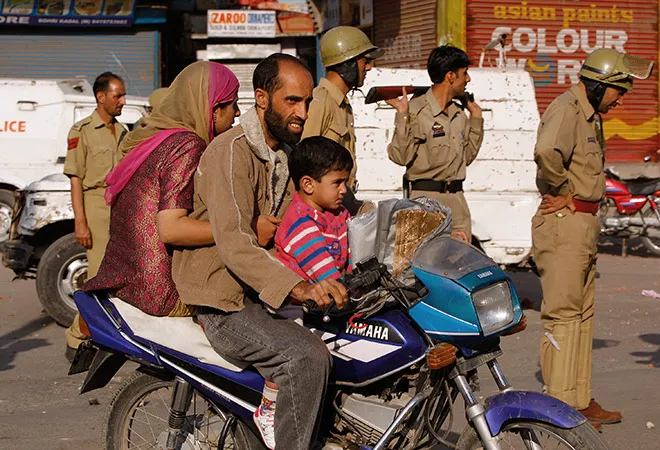
After three years of consistent and escalated counter-insurgency operations, the Valley of Kashmir is experiencing relative calm of late. The reduction in incidents of civil unrest, especially stone pelting, and sharp drop in recruitment in terrorist organisations – especially since past four months – indicates positive change. This could not have been achieved without strategically-crafted counter terror operations targeting terror leadership in the Valley as well as calculated, yet bold, cross-border military offensives against Pakistan’s strategic assets. However, the current semblance of fragile calm in Kashmir can blow up any time, given Pakistan’s ability to revive its proxy and hybrid war tactics.
The reduction in incidents of civil unrest, especially stone pelting, and sharp drop in recruitment in terrorist organisations – especially since past four months – indicates positive change.
The Kashmir conflict is a mixture of domains – comprising of conflict psychology, information campaigns, finances, social media, perception management, political manoeuvring, diplomacy etc. Military is just a subset of it. Military engagement gains prominence in such a conflict because it can primarily control the situation creating an environment in which the much more complex domains can be addressed. Therefore, New Delhi must seize the opportunity of the prevailing relative calm in the Valley to employ smart power, i.e. a combination of hard and soft power.
New Delhi must seize the opportunity of the prevailing relative calm in the Valley to employ smart power, i.e. a combination of hard and soft power.
The period 2008-10 saw a resurgence of violent clashes in Kashmir, giving rise to a new generation of protestors, who later resurfaced in 2016. The Amarnath Land row in 2008 and the Machil fake encounter of 2010 vitiated the environment in the Valley. However, the period of November 2010 to October 2011 in a sense displayed a sense of great hope, which soon turned into great despair in the Valley. The visit of the first-ever group of civilian interlocutors engaged the Kashmiri society at every level and made crucial recommendations that were largely appreciated by the local population. However, the government shelved the recommendations that could have to a large extent helped in the reduction of human rights violations and facilitated an improvement in the relations between security forces and the Kashmiri society. Non-implementation of the interlocutors report created widespread resentment and mistrust against New Delhi in the minds of the Kashmiri people.
The visit of the first-ever group of civilian interlocutors engaged the Kashmiri society at every level and made crucial recommendations that were largely appreciated by the local population.
Despite this lack of response from New Delhi, in 2012, the Valley remained calm. Tourists had once again started to pour in. There was hope once again, but it was short lived. Radha Kumar writes in her book ‘Paradise at War: A political history of Kashmir,’ that to prevent the atmosphere from stabilising, Pakistan-backed terror organisations Jaish-e-Mohammad (JeM) and Lashkar-e-Toiba (LeT) started to push in infiltrators and increased fresh recruitment of locals in their folds. In February 2013, the execution of Afzal Guru further alienated the Kashmiris.
The initiative was also lost as the UPA government was busy fighting corruption allegations made against its several ministers and later got busy preparing for 2014 general elections. The BJP, high on winning a strong mandate in May 2014, joined hands with the PDP to form the government in Jammu and Kashmir in November. The alliance was dubbed as unholy and arrival of Hindu communalists, who wanted to change the local demography and abrogate the special Constitutional provisions accorded to the state. Post Afzal Guru's death sentence, LeT and JeM struck many targets across the country in 2015 and Pakistan-sponsored terrorism peaked new heights with the Pathankot and Uri attacks in 2016. While these attacks spoiled the ties between New Delhi and Islamabad, the elimination of Hizbul Mujahideen commander Burhan Wani in the same year was the final trigger – throwing the entire Valley in a spiral of violence.
In a way, 2016 was the repeat of the 1990s – both in terms of Pakistan applying its hybrid war tactics and India responding with only military crackdowns. Strong and effective counter narratives and engagement of Kashmiris at the political and societal level were conspicuous by their absence, as terror was dealt only with fierce force. In the past 30 years, India has not been able to completely contain the terror networks in the Valley and defeat the terror ideology largely because the government has continued with its hard approach – even during times of relative peace and normalcy. Use of hard power, the norm in the 1990s, slowly gave way to soft power engagement under the rule of Prime Minister A B Vajpeyee, who is still revered by Kashmiris for his balance and humane approach. Today, the situation once again demands the delicate rebalancing of hard and soft power.
India has not been able to completely contain the terror networks in the Valley and defeat the terror ideology largely because the government has continued with its hard approach – even during times of relative peace and normalcy.
Hybrid war, as is being witnessed in Kashmir, covers a full spectrum. It remains below the threshold of a conventional war, but it continues to simmer even during peaceful times. Pakistan has applied various tools of hybrid warfare in last three decades of its state-sponsored terrorism. However, in past three years, especially, Islamabad has strategically used social media platforms to exacerbate on ground trouble for New Delhi. Social media platforms have been used to successfully carry out radicalisation and local recruitment drives. It also successfully reintroduced suicide bombings in the Valley, while raking up instances of human rights violations at various international fora. Despite this, India’s all-out offensive against terrorism has paved way for relative stability to return after a tumultuous period of two-and-a-half years. The elimination of most of the terror leadership will also help the forces to keep an upper hand. However, a lot will depend on how New Delhi deals with the Kashmir Valley in the coming months – irrespective of whether the same dispensation returns to power at the Centre or not and also given how Pakistan again ups its ante in the Valley.
Hybrid war, as is being witnessed in Kashmir, covers a full spectrum. It remains below the threshold of a conventional war, but it continues to simmer even during peaceful times.
Pakistan is at a crucial juncture. It is facing severe shortage of foreign exchange reserves. How Pakistan overcomes it domestic cash crunch and still manages to finance terror groups like JeM and LeT that are constantly engaged in anti-India activities at Islamabad’s behest would have a bearing on how the situation unfolds in the Valley. Pakistan, therefore, will see another 2016-like situation in the Valley as far more profitable an option than to let the current downturn in violence stabilise.
On the other hand, the impact of India’s diplomatic victory at UNSC for the naming of Masood Azhar as a global terrorist as well the moral-boosting Balakot air raids is likely to be very modest. Each period of lull has seen terror groups remerge in Kashmir with a collective strength, expanding their area of operations. In that light, the alleged declaration of Kashmir as a ‘province’ by the Islamic State (IS) must not be ignored, as wide-spread radicalisation in the Valley is already posing the biggest challenge to New Delhi.
The impact of India’s diplomatic victory at UNSC for the naming of Masood Azhar as a global terrorist as well the moral-boosting Balakot air raids is likely to be very modest.
For far too long, New Delhi has tried to address the Kashmir conflict through military means and have offered lip service by stating its willingness to find a lasting solution through the process of peaceful and constructive dialogue. However, neither pure military means nor mere political talks can address the complexities of the conflict. A strong government that can think beyond petty political gains and strike an optimum balance between the deployment of hard and soft power will stand a chance to address the issue. Dictator-like attitude in handling of the matter would further spoil New Delhi’s case in Kashmir. It will create further civil and political unrest and give Pakistan another chance on a platter.
The views expressed above belong to the author(s). ORF research and analyses now available on Telegram! Click here to access our curated content — blogs, longforms and interviews.




 PREV
PREV


